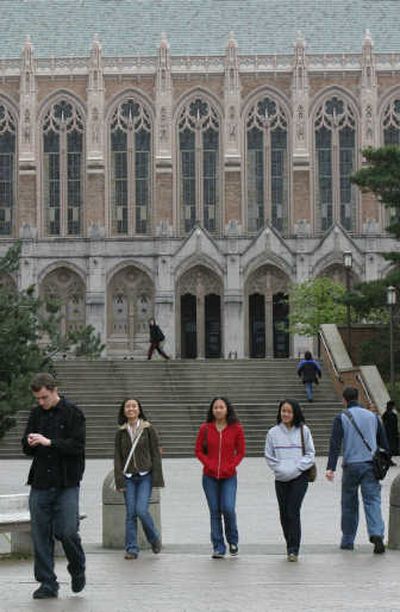College costs again outpace inflation

The price of college again rose faster than the inflation rate this year, climbing 6.6 percent at four-year public schools and outstripping increases in the financial aid that lowers what most students actually pay.
The latest increases, reported Monday by the College Board, bring the average list price of four-year public universities to $6,185 this year, up $381 from 2006-2007. At four-year private colleges, tuition and fees rose 6.3 percent to $23,712.
Public two-year colleges – which educate about half of American college students – again got the best marks for keeping a lid on price increases. Their average price rose 4.2 percent to $2,361. Accounting for aid, their average net cost is $320 per year.
“For too long, parents have grimaced and borne the high price of college because they presumed that a higher education is key to their child’s success in today’s economy,” said James Boyle, president of the group College Parents of America, in a statement on the report. “Surely, the day will come – soon – when parents say enough is enough.”
The published price is not the out-of-pocket price for many students, thanks to financial aid, but the net price is rising too. On average, accounting for grants and tax breaks, the net price for full-time students at four-year public universities this year is $2,580. That’s about $160 more than last year.
At private colleges, net cost this year averages $14,400 – up $638 from a year ago.
To make up the difference, students typically borrow as much as allowed from the federal government, but then turn to private student loans. A decade ago, nonfederal loans accounted for about 6 percent of student aid, but last year they were 24 percent.
The rate of growth in private borrowing slowed last year. But that was at least partly because of new rules allowing graduates students to take out PLUS loans from the federal government. For undergraduates, private borrowing still rose 12 percent to $14.5 billion.
Including room and board for students living on campus, charges for public four-year colleges were $13,589, or 5.9 percent higher than last year. At private four-year schools, average total charges come to $32,307.
George Washington University in Washington, D.C., recently attracted attention for becoming the first major university with a published price, including room and board, of more than $50,000.
However, fewer than 10 percent of students attend colleges with tuition and fees higher than $30,000, according to the College Board, and many of those students receive financial aid. About 56 percent of students at four-year colleges attend schools listing a price less than $10,000, and about one-third attend schools charging less than $6,000.
The College Board’s report does not try to explain why prices keep going up, though Sandy Baum, an economist with the group and at Skidmore College, points out that because of rising demand for higher education, more state appropriations have not translated into more money spent on each student.
The report comes as Congress is in the early stages of considering a proposal that could require some colleges with large endowments to spend more of their savings to keep tuition down. Colleges call the idea misguided and say it wouldn’t solve the underlying economic issues causing price increases.
For the first time, the College Board report includes the rapidly growing sector of for-profit education, which now caters to about 8 percent of students. Their average prices also are rising rapidly – to $12,089, up 6.2 percent from last year.
Peter McPherson, president of the National Association of State Universities and Land Grant Colleges, issued a statement saying, “Leaders of America’s public research universities continue to be concerned about the impact that the cost of attending colleges has on students and their families.” But, he said, the average net price of $2,600 at four-year schools remains “excellent value.”
That contention is supported in a recent paper by Mark Kantrowitz, publisher of the financial aid Web site finaid.org. He tried to estimate how much a four-year college degree would have to cost before it would no longer be a good investment, given the $1.2 million increase in expected lifetime earnings that comes with a bachelor’s degree. His answer: about $520,000 – or $130,000 a year.